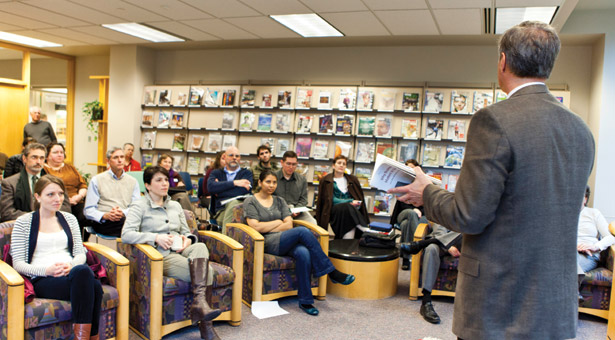Education Teaching and Learning
Collaborative Education in the Digital Age
The New Academic Library
By Jeffrey Overstreet (jeffreyo@spu.edu)

The SPU Library also plays host to conversations: At "Thursday Food for Thought," in the Library's Reading Room, faculty and staff authors at SPU read from and discuss their latest publications.
On the lower level of the Seattle Pacific University Library, two students — senior Trevor White and junior Shane Pech — lean toward large iMac screens, editing their own movie with Final Cut Pro.
"Pretty much anything you need to do technology-wise, you can do here," says White, who also makes a monthly video of student interviews for an e-magazine in the Library.
At the technology desk, a student worker tutors another student on how to use animation in her PowerPoint slideshow, while still another student checks out a Flip camera for use outside the Library.
Nearby, three students view their final class project, complete with text and diagrams, on a big screen. Together, they discuss the content and make changes.
Filmmaking? Animation? Collaborative editing? "It's 2011. A lot has changed … is changing," says Bryce Nelson, the SPU Library's director.
Playing tour guide, Nelson notes that the world of academic resources required for learning is increasing exponentially. The latest technology, a substantial library collection, expert teaching librarians, and an effective library website help attract and keep first-rate students and faculty members. He is devoted to providing these cutting-edge resources — but there's a catch.
"No library can afford to do this alone anymore," Nelson explains. "We need to be part of a consortium. So we might as well be a part of the best consortium in the United States. And we are."
Orbis Cascade Alliance connects 36 academic institutions in Oregon and Washington. More than 225,000 students benefit from a combined catalog and borrowing system, and vast collections of books, DVDs, CDs, paper journals — and electronic resources such as e-books.
It's a cost-effective strategy for university libraries in the digital age. As printed academic journals are replaced by electronic versions, for instance, subscriptions become more expensive. "This is the most difficult economic problem in front of academic libraries today," explains Nelson. Through the Alliance, however, group purchases mean costs are shared and member libraries strengthened.
Another plus is that printed journals can now be recycled and library space used differently. Nelson has seen to it that there is space in the SPU Library — complete with view windows and display of student coursework — for a variety of purposes. Some students need quiet rooms for reading and research. Others need to brainstorm with classmates, collaborate on multimedia projects, access web-based collections, and publish reports. What was storage space for journals has become today's learning workshop.
All of this requires a first-rate infrastructure. Much of what brings the new world of digital resources to students — both inside this building, and through the Library website — is sophisticated wiring hidden in the building's walls.
The "infrastructure" of the academic library also includes its outstanding staff. "Our librarians are faculty members," says Nelson."They're experts in information literacy, teaching students the skills to find what they need."
It takes a clear view of the future to guide today's academic library. And Nelson has knowledge, vision and wisdom, says Les Steele, SPU vice president of academic affairs. "What is also striking about Bryce is his deep sense of the aesthetics of library space. He beckons people to come and learn."
